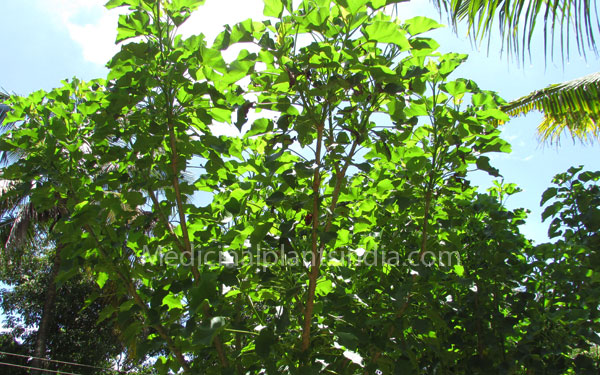
English: Purging nut
Sanskrit: Dravanti
Hindi: Pahari erand
Malayalam: Kattavanakku, Appa-അപ്പ, Kammatti
Growth Habit: It is a fast-growing, deciduous shrub or small tree that can reach a height of 5 to 7 meters (16-23 ft), though under optimal conditions it can grow taller.
Leaves: The leaves are green, alternate, and broad with a heart-shaped (cordate) base. They typically have 3 to 5 shallow lobes and are 10-15 cm long and wide. The leaves are shed during the dry season.
Flowers: The plant is monoecious, meaning it bears both male and female flowers on the same inflorescence. The flowers are small, greenish-yellow, and borne in loose clusters (cymes) in the leaf axils. A single inflorescence can produce dozens of male flowers and only a few (typically 1-5) female flowers.
Fruit: The fruit is an ovoid capsule, about 2.5-4 cm long. It is green when immature and turns yellow to dark brown as it matures. Each fruit typically contains 2-3 seeds.
Seeds: The seeds are oblong, black, and about 2 cm long. They resemble small beans. The seed coat is thin but hard, enclosing a kernel that is rich in oil (30-40% by weight).
Useful plant parts:
Whole plant.
Medicinal uses:
Traditional Medicine
Nearly all parts of the plant have been used in traditional medicinal systems, but they must be used with extreme caution due to toxicity.
Seeds: Powerful purgative (hence the name “Purging Nut”). Also used for skin diseases and to treat rheumatism.
Latex (Sap): Applied topically to wounds to stop bleeding, for burns, and as a disinfectant. It has been shown to have antimicrobial properties.
Leaves: Decoctions are used to treat malaria, fever, and inflammation.
Roots: Used as an antidote for snakebites.
Chemical Content:
Flavonoids: (e.g., apigenin, vitexin, isovitexin) – Antioxidant, anti-inflammatory properties.
Alkaloids
Tannins – Astringent properties.
Saponins
Phenolic compounds – Strong antioxidants.
Small amounts of phorbol esters may also be present.
Copy rights 2013-2024 Medicinal Plants India : All rights reserved.